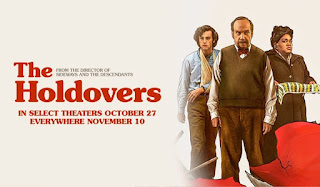by A.J.
Best Pictures #98: 2023 (96th) Academy Awards Best Picture Nominee
“Not being able to relate to people isn't a badge of honor.”
Satire is difficult enough, but successfully blending satire with recognizable everyday emotions is a most challenging feat that writer-director Cord Jefferson accomplishes with his more than impressive debut feature, American Fiction. It helps that he has Jeffery Wright in the lead role giving one of the best performances of 2023; Wright has very deservedly received a Best Actor Oscar nomination. More than just a hilarious satire of the literary world and perceptions of race, American Fiction is also a moving family drama, a smart comedy, and the kind of character study that feels like a throwback to the challenging and offbeat films of the late 1960’s and early 70’s.
Wright plays Thelonious “Monk” Ellison, a talented but commercially unsuccessful author and college professor. Monk reaches a breaking point when his latest novel is rejected by publishers while a novel by another Black intellectual, Sintara Golden (Issa Rae), that indulges in stereotypes and street dialect so extreme it sounds more ridiculous than authentic, becomes a bestseller. His frustration leads him to write a parody of “Black trauma porn” called My Pafology under the incredible pseudonym Stagg R. Leigh. He has his agent send it to publishers as a joke but the joke is on Monk because they think it is a serious book and offer a very big payday.
Monk reluctantly takes the money because of the events of the other storyline: his family problems. A forced sabbatical from his university prompts Monk’s return to his hometown of Boston and the nearby family beach house. After a sudden tragedy, he finds himself the primary caretaker of his mother, Agnes (Leslie Uggams), who is in the early stages of dementia. His brother, Clifford (Sterling K. Brown), is little help as he’s going through his own major life events: a divorce and coming out as gay. A bright spot for Monk is a potential relationship with a neighbor, Coraline (Erika Alexander), a recently divorced public defender. Some extra money, and frustration, comes from being a jury member for a literary award with his would-be nemesis Sintara Golden and ends up judging his own secret book, a favorite of the white jury members.
Wright, who conveys so much while seeming to do so little, is grumpy and frustrated but not without reason and a lighter, even happy, side comes out in early scenes with Tracee Ellis Ross as his sister and later in scenes with Erika Alexander. Sterling K. Brown, who earned a Best Supporting Actor Oscar nomination for his performance, also does a great job handling comedy, drama, and believability. Each character feels like a person that you might know or maybe recognize in yourself. They also feel like they have lives outside of each other. Jefferson’s screenplay, adapted from the 2001 novel Erasure by Percival Everett, allows each character layers and dimensions; no one is only one thing.
Most, but not all, of the comedy comes in the scenes dealing with the literary world. Monk has to pretend to be the escaped convict turned novelist Stagg R. Leigh which makes for some awkward and funny scenes. He does everything he can think of to kill the novel once he realizes that no one got the joke, but nothing will stop the hilariously obsequious, and ever frightened of offending, white publishing executives. Also, anyone who took any writing classes or advanced literature courses will very likely recognize the personality types of the three white literary award judges.
Jefferson includes some broad stylistic choices, some of which might be more welcome than others depending on your sensibilities. When Monk writes My Pafology we see the characters from his novel spring to life in front of him and act out his writing. When he gets stuck, one of the characters (played by the great Keith David) turns and questions Monk. The ending is a bit of a departure from the rest of the film. Things don’t wrap up nicely with a bow and closure on each plot point, but life rarely wraps up that way. 














